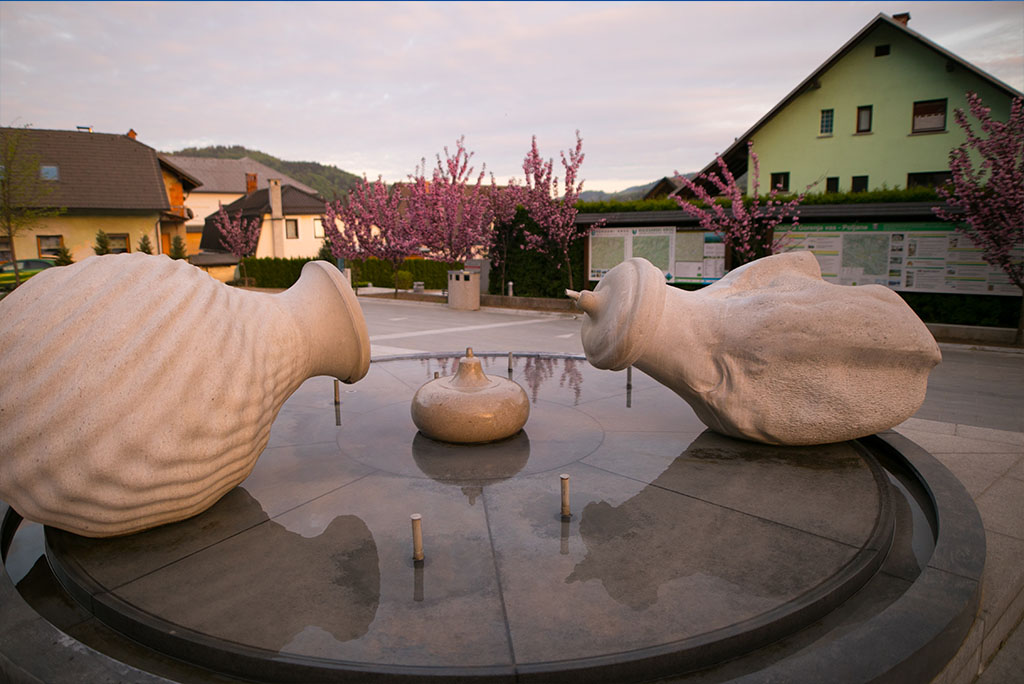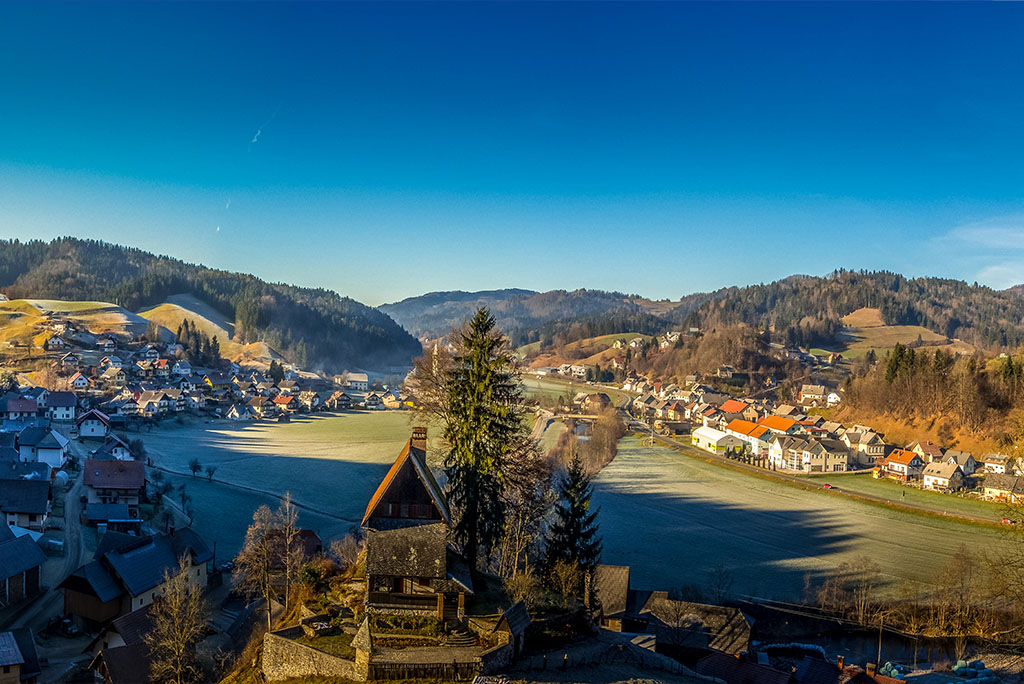Vsak letni čas je tukaj po svoje lep. Prav gotovo pa je bilo tukaj najlepše takrat, ko je pomlad s svojim krilom plavala nad dolino. In če je v Poljanski dolini lepa pomlad, tedaj je malokje lepše˝, je na kratko zapisal Ivan Tavčar o Poljanski dolini.
Poljanska dolina, nekdaj del Loškega gospostva, sestavlja več slikovitih krajev, ki jih povezuje skupna zgodovina, danes pa so povezani v občini Gorenja vas – Poljane. Zgodovinska poročila o dolini segajo v leto 973, ko je nemški cesar Oton II. del doline skupaj s Škofjo Loko in Selško dolino daroval freisinški škofiji na Bavarskem, ki je območju vladala vse do 19. stoletja. Dolina je bila poseljena že pred prihodom freisinških škofov, nekateri poseljenost datirajo celo v čas pred prihodom Keltov na naš prostor, vendar za obdobje pred 10. stoletjem ni ohranjenih nobenih zapisov o ozemlju. .
V osrčju občine, zahodno od Poljan, je upravno središče Gorenja vas s čedalje izrazitejšimi trškimi značilnostmi, kjer je ob osrednjem trgu, Trgu Ivana Regna, nastalo zgoščeno trgovsko-storitveno jedro naselja. Po vojni je Gorenja vas z združitvijo skupine manjših vasi na obeh bregovih Sore in hitrim razvojem delovnih mest naglo prerasla v največje naselje v občini.
Na osrednjem trgu stoji Vodnjak ljubezni v času murenčkov , delo akademskega kiparja Metoda Frlica. Kipar o vodnjaku pravi, da predstavlja družino, kjer ljubezen med žensko in moškim zamenja rojstvo otroka.
Simbolna geometrijska oblika otroka predstavlja njegovo čisto dušo, ki še ni prepojena z duhom našega časa. Vrč, s katerim nosimo vodo- vir življenja- simbolizira mater. Mišična gmota pa simbolizira očeta, ki z zadnjimi gibi počasi izgublja svojo vlogo, saj je vedno bliže zunanjem robu.
GORENJA VAS – IVAN REGEN
„Jede Jahreszeit ist hier auf ihre Art schön. Doch es war sicherlich die schönste Zeit hier, als der Frühling mit seinem Flügel über dem Tal schwebte. Und wenn es im Poljanska-Tal einen schönen Frühling gibt, ist es selten wo schöner „, hat Ivan Tavčar kurz über das Poljanska-Tal geschrieben.
Das Poljanska-Tal, einst Teil der Herrschaft von Loka, besteht aus mehreren malerischen Orten, die eine gemeinsame Geschichte verbindet und heute in der Gemeinde Gorenja vas – Poljane vereint sind. Historische Berichte über das Tal reichen in das Jahr 973, als der deutsche Kaiser Otto II. einen Teil des Tals zusammen mit Škofja Loka und dem Tal Selška dolina dem Freisinger Bistum in Bayern schenkte, das das Gebiet bis zum 19. Jahrhundert regierte. Das Tal war schon vor der Ankunft der Freisinger Bischöfe bewohnt, manche datieren die Besiedelung sogar in die Zeit vor der Ankunft der Kelten in unseren Raum, jedoch sind aus der Zeit vor dem 10. Jahrhundert keine Aufzeichnungen erhalten.
Im Herzen der Gemeinde, westlich von Poljana, ist das Verwaltungszentrum Gorenja vas mit zunehmend ausgeprägten Marktmerkmalen, wo sich am zentralen Platz, dem Ivan-Regen-Platz, ein verdichteter Handels- und Dienstleistungskern der Siedlung bildete. Nach dem Krieg wuchs Gorenja vas mit der Zusammenlegung mehrerer kleiner Dörfer auf beiden Seiten der Sora und der raschen Entstehung neuer Arbeitsplätze schnell zur größten Siedlung in der Gemeinde heran.
Auf dem zentralen Platz steht der Liebesbrunnen in der Zeit der Schildkröten – das Werk des akademischen Bildhauers Metod Frlic. Der Bildhauer sagt über den Brunnen, dass er eine Familie darstelle, in der die Liebe zwischen einer Frau und einem Mann durch die Geburt eines Kindes ersetzt wird.
Die symbolische geometrische Form des Kindes repräsentiert seine reine Seele, die noch nicht vom Geist unserer Zeit durchtränkt ist. Der Krug, mit dem wir das Wasser – die Quelle des Lebens – tragen, symbolisiert die Mutter. Und die Muskelmasse symbolisiert den Vater, der mit den letzten Bewegungen langsam seine Rolle verliert und er immer näher dem Außenrand ist.
GORENJA VAS – IVAN REGEN
»Each season of the year has here its own charm. But it is never more beautiful than when the spring comes and softly spreads its wings above the valley. Almost nowhere does one meet so beautiful spring as here in the Poljane valley.» , wrote in short the renowned writer Ivan Tavčar about his valley.
The Poljane valley, once a part of the Loka dominion , consists of several picturesque places, which are connected by the mutual history and today they are parts of the Municipality Gorenja vas- Poljane. Histrorical reports about the valley date back to the year 973, when the German Emperor
Oto II. donated a part of the valley together with Škofja Loka and the Valley of Selška Sora to the Diocese of Freising in Bavaria, which ruled this territory till the 19th century. The valley was inhabited already before the arrival of the Freising bishops, some sources even quote the habitation back to the time before the Celts’ arrival to the area, however there are no preserved records about the territory for the period preceding the 10th century.
In the heart of the municipality, west from Poljane, there is the administrative center Gorenja vas with clearly evident urban characteristics, where beside the central square , Square of Ivan Regen , the thick trade -service core of the settletment was formed. After the war Gorenja vas swiftly grew to the largest settlement in the municipality with the merger of several smaller villages on both sides of Sora river and with the quick development of the employment.
On the main square there is the Fountain of Love in the time of crickets, the masterpiece of the academic sculpturer Metod Frlic. The sculpturer comments that the fountain represents a family, where the love between the woman and the man is replaced by the birth of the child.
The symbolic geometrical form of the child represents its pure soul, which is not influenced yet by the spirit of our time . The jug, in which we carry the water- the source of life- symoblises the mother. The muscle formation however symbolises the father, who – in his final activity slowly loses his role, since he moves closer and closer to the outer edge.



